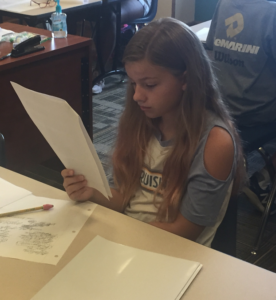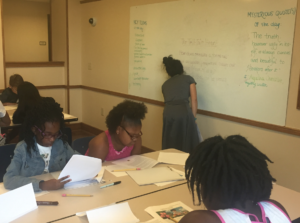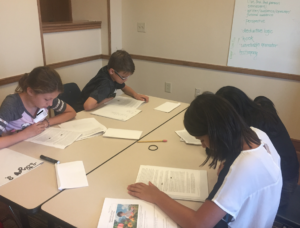Summer SAVY 2018: Session 4, Day 1 – Mysterious World in Writing (Rising 5th/6th)
Welcome to Mysterious World In Writing, parents! So happy and honored to be trusted with your students for the week, and I look forward to our mysterious literary adventures ahead.
This morning, we opened the class with a discussion of our initial assumptions about mysteries and mystery-writing. The students were incredibly enthusiastic about mysteries they’ve already seen/heard/read, and we created a whiteboard “web” of specific qualities that might make mysteries successful page-turners: suspense, puzzle-solving, placing agency on the reader, plot twists, dead ends, cliffhangers, and sensory cues.
We then began a short lesson on multiple literary perspectives, where students watched two short clips (A and B) in Hayao Miyazaki’s film The Secret Life of Arrietty, and discussed the ways that Miyazaki employs different literary perspectives to garner sympathy and generate suspense for his protagonists and antagonists. Following this viewing was an overview of perspective in storytelling: 1st person, 3rd person (limited and omniscient viewpoints), and different effects that each perspective might have on stories themselves. 1st person, for example, can create an intimate, relatable interiority of character for the reader, while 3rd person might seem more distant, and less personal (although initially seem more trustworthy at first!)
Students discussed broadly the “Evil vs. Good” binary, and talked as a group about the characteristics one might attribute to protagonists and antagonists. We then discussed the merits of telling the story from an antagonists’ point of view.
To illustrate an example of literary perspective in the 1st person as told by an antihero (antagonist), we read Edgar Allen Poe’s The Tell-Tale Heart. Students were asked to consider how revealing a “criminal’s” perspective changes our perception of his character, and why Poe may have chosen to tell this story in the 1st person, rather than the 3rd. We also discussed reliable narration — and came to the conclusion that the narrator in the story is, in fact, unreliable. Throughout our conversation, we discussed using context clues and marginalia (writing in the margins! Notes, questions, etc.) to serve our process as close readers. Students were encouraged to free-write in the few minutes before lunch — to continue Poe’s story in the 1st person and creatively imagine the ‘after’-tale…What might Poe’s narrator do upon being discovered as the murderer?
In the afternoon, we focused on Mysterious Hooks — first lines, first pages, beginnings of mysteries. Students listened to an out-loud reading of the first three pages of Inkheart, by Cornelia Funke, and discussed what successful “hooks” do for mysteries — draw you in, tease a further discovery, pose a question, etc.
Students then read out-loud the first scene of Agatha Christie’s famous mystery play, The Mousetrap. They had a lot of fun with this one! They were engaged and fantastic readers, and very interested in the ways that dialogue and character traits were brought out of Christie’s [screen]writing, in addition to the ways suspense was built in the beginning. Students were also given brief context of Christie’s writing life, and The Mousetrap itself — for example, her books rank as the 3rd most widely-published books in the world (behind Shakespeare and the Bible!).
Students completed a Build-A-Character handout, where they practiced creating characters for their mystery stories this week, focusing on motive, and then free-wrote the beginnings of their mystery stories based on these characters. We discussed a basic story arc: exposition, rising action, climax, and resolution.
Finally, we completed a “Writers’ Tote Bag” exercise, where three random objects (a mason jar, a construction hat, and a tote bag with a plastic fork inside) were selected by student volunteers. The challenge for students was to include one (or all!) of these seemingly random objects into the “mystery” of their story. We concluded the day with some more writing and idea-parsing of creative stories for the week!
The goal of the course will be for each student to have completed a mystery short story by the end of the week, and, of course, to expand their knowledge of the craft, technical vocabulary, close reading skills, and process of writing (and reading) mysteries. I hope the students feel that, throughout the week, they are participating in an active community of young writers and puzzle-makers!
Looking forward to tomorrow.
-Ms. Carlina
Some of Today’s Work




